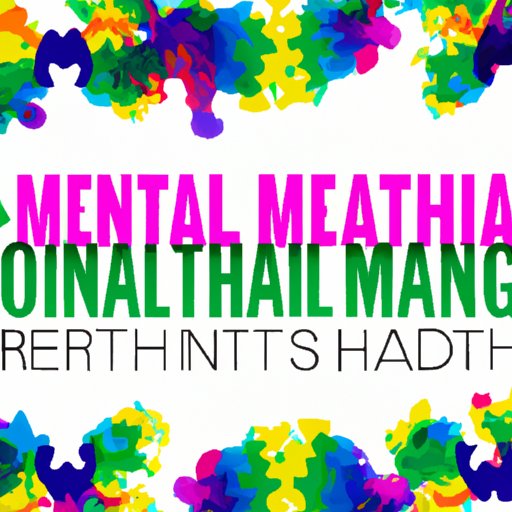
I. Introduction
The topic of mental health is becoming more widely acknowledged and discussed in society, with the aim to break the stigma and promote a better understanding of mental health issues. When it comes to spreading awareness about mental health, colors can be a powerful tool in conveying emotions and messages. This article will explore the significance of different colors in mental health awareness campaigns and why they can make a difference.
II. Exploring the Significance of Green in Mental Health Awareness Campaigns
Green has historically been associated with mental health awareness, with the first green ribbon campaign originating in America in 1973. Green is linked to balance and harmony, and therefore can represent the balance and harmony we hope to achieve in our inner lives.
Green is also associated with growth and renewal, which can represent the transformation that can come with mental health treatment. Green is a calming color, and therefore can help to promote a sense of peace and tranquility, which is beneficial to those struggling with mental health issues.
Successful green-themed mental health campaigns include the Mental Health Awareness Week in the UK and Ireland, which is driven by the Mental Health Foundation and uses the slogan “Nature is key- unlock your well-being”. The campaign aims to promote mental health using nature as a tool to aid recovery and to show that it is possible to boost your mental health by spending time around nature.
III. The Power of Color: How Blue is Changing the Conversation About Mental Health
Blue has become increasingly popular in mental health advocacy, largely due to its calming effects. Blue is often associated with the sea, the sky, and a calmness that can be a great relief for those struggling with mental health issues. The color blue is also associated with stability and reliability which can promote a sense of reliability in mental health services or campaigns that use this color to raise awareness of mental health issues.
Successful blue-themed mental health campaigns include the Blue Knot Foundation, which is the National Center of Excellence for Complex Trauma in Australia. The foundation promotes awareness of childhood trauma, which is essential for mental health support and treatment.
IV. Painting a Brighter Future: The Role of Yellow in Mental Health Promotion
Yellow is the color associated with happiness and energy, which can influence people to have a positive outlook on life. Yellow is also associated with warmth, and by using yellow in mental health campaigns, it can provide a sense of inviting and welcoming that is necessary for people struggling with mental health issues.
Yellow has been associated with hope and optimism for generations, which is why it is used in suicide prevention and mental health awareness campaigns. Happy Valley Pride is an LGBTQ+ charity that uses the color yellow in its campaign to promote awareness of mental health and well-being in the LGBTQ+ community.
V. Seeing Red: Why the Color Red is Critical in Drawing Attention to Mental Health
Red is an eye-catching color, and therefore can be effective in drawing attention to mental health. Red is the color of urgency and can signify the importance of addressing mental health issues. It is widely linked to passion, love and anger which can signify the feelings of those who are struggling with mental health issues.
Examples of campaigns that have successfully used red as a primary color are the Red Band Project that raises awareness about teenage depression and suicide, and the Red Cross that uses the color to raise funds to support mental health services.
VI. From Pink to Purple: The Evolution of Colors Representing Mental Health Awareness
The colors associated with mental health awareness have evolved over time. While shades of green have traditionally been a key feature in mental health campaigns, other colors have emerged in recent years. Pink is a color often associated with breast cancer awareness, and it is now also used in campaigns that promote good mental health. Purple is another notable color associated with mental health, as it conveys a sense of spirituality, calmness, and strength.
Examples of campaigns that have used a variety of colors are Movember Australia that raises awareness on men’s mental health, the Black Dog Institute’s “One in Five” campaign that uses a mix of greens and blues for depression awareness, and “Do it for Dolly” anti-bullying campaign, which uses the traditional blue with hints of hot pink to convey awareness of suicide prevention and mental health issues.
VII. Conclusion
Colors can be a powerful tool in promoting mental health awareness and conveying important messages to society. Each color carries its own symbolism and meaning that can evoke emotions that are important for people struggling with mental health issues. By understanding the significance of color in mental health campaigns, we can reach a broader audience and create a brighter future for people living with mental health issues.




